Hardware in Field Cameras
Almost all camera hardware (the little metal bits and pieces that operate the mechanisms) in the period 1870-1930 was brass. However, some cameras had nickel-plated brass hardware, and the finish of the hardware varied with the splendor of the camera desired by the manufacturer.
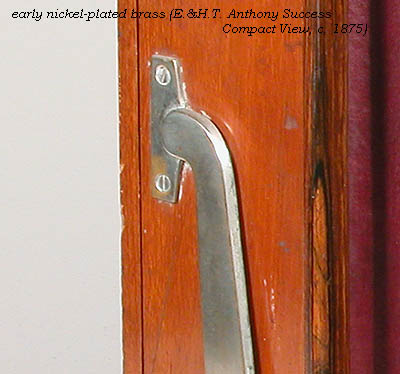 The
1870's and early 1880's saw a number of cameras having nickel-plated
hardware. The brass underneath was well finished, so the nickel
was meant to enhance the appearance rather than to cover a defect.
Most early Blair cameras fall into this category, as well as a number of
high-end Anthony. But American Optical and Scovill stuck to plain
brass, it seems.
The
1870's and early 1880's saw a number of cameras having nickel-plated
hardware. The brass underneath was well finished, so the nickel
was meant to enhance the appearance rather than to cover a defect.
Most early Blair cameras fall into this category, as well as a number of
high-end Anthony. But American Optical and Scovill stuck to plain
brass, it seems.
Un-plated brass had different treatment, depending on the price of the camera:
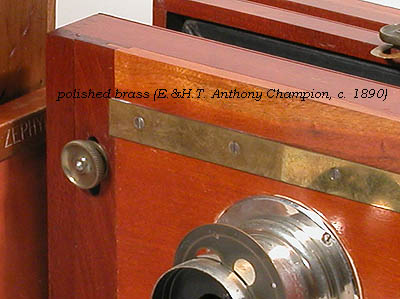
Lower price cameras had plain, stamped or cast parts, with little treatment other than some polishing. These pieces usually did not have any protective coating, and so oxidize over time.
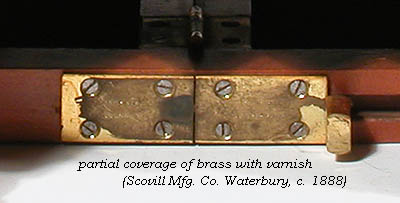 Apparently
some cameras were completely assembled prior to the varnish application
-many Scovill Waterbury cameras show signs of the uncoated brass
hardware partially covered by a varnish coat.
Apparently
some cameras were completely assembled prior to the varnish application
-many Scovill Waterbury cameras show signs of the uncoated brass
hardware partially covered by a varnish coat.
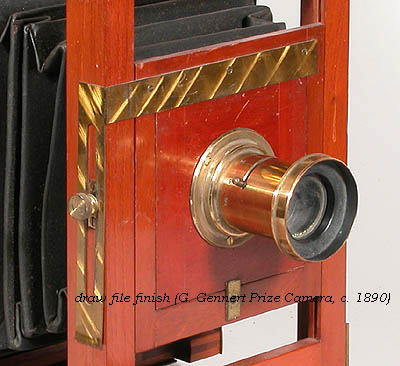 Several
companies, including E.&H.T. Anthony and G. Gennert treated the brass
parts of their finer cameras with what was called draw file finishing.
Draw-filing is the act of holding a file parallel to the work and
drawing it towards you, creating a pattern of parallel scratches
in the brass. Sometimes, the pattern was complex, as in the
example here. Such finely finished hardware deserved an equally
fine protective coating. Reportedly, the brass part was heated, to
which the varnish or shellac was brushed. Personally, I never
managed to get the knack of that operation, usually producing a series
of brush marks instead of the smooth finish that the old masters made.
Several
companies, including E.&H.T. Anthony and G. Gennert treated the brass
parts of their finer cameras with what was called draw file finishing.
Draw-filing is the act of holding a file parallel to the work and
drawing it towards you, creating a pattern of parallel scratches
in the brass. Sometimes, the pattern was complex, as in the
example here. Such finely finished hardware deserved an equally
fine protective coating. Reportedly, the brass part was heated, to
which the varnish or shellac was brushed. Personally, I never
managed to get the knack of that operation, usually producing a series
of brush marks instead of the smooth finish that the old masters made.
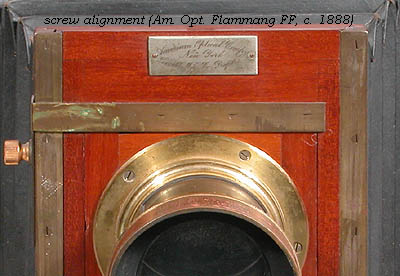 Another
feature of high-end cameras having the draw-file finish was that screws
were chosen at random to fit with their slots aligned, then filed down
flush along with the part. American Optical cameras almost always
were produced this way, as in the example. Note that on the back
of the camera, the screws are aligned parallel to the circle of brass.
Another
feature of high-end cameras having the draw-file finish was that screws
were chosen at random to fit with their slots aligned, then filed down
flush along with the part. American Optical cameras almost always
were produced this way, as in the example. Note that on the back
of the camera, the screws are aligned parallel to the circle of brass.
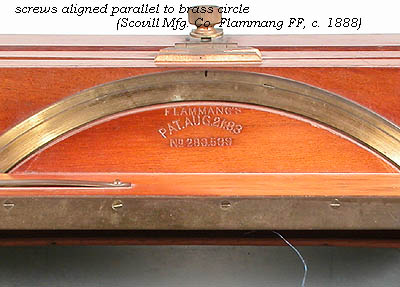
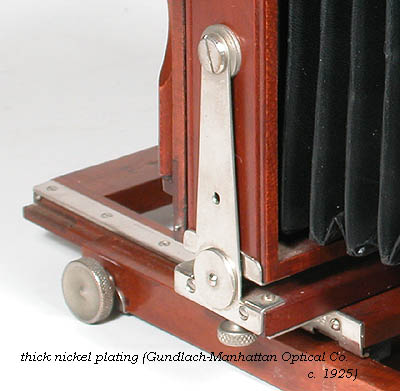 By
the 1900's, the labor-intensive draw-file finish had disappeared,
apparently due to pricing pressures. It was replaced on high-end
models by nickel-plated brass. In this period, the nickel was not
the thin, elegant nickel of the 1880's, but instead a rather thick
coating, apparently used to cover up the fact that the underlying brass
was pretty much as cut or stamped, without any hand work involved.
By
the 1900's, the labor-intensive draw-file finish had disappeared,
apparently due to pricing pressures. It was replaced on high-end
models by nickel-plated brass. In this period, the nickel was not
the thin, elegant nickel of the 1880's, but instead a rather thick
coating, apparently used to cover up the fact that the underlying brass
was pretty much as cut or stamped, without any hand work involved.
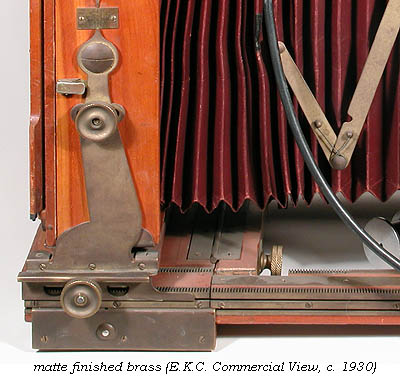 The
commercial, middle or low-end cameras naturally fared worse than the
high-end cameras in the 1920's and 1930's, as polished brass gave way to
matte-finished or perhaps we should say un-finished brass.
The
commercial, middle or low-end cameras naturally fared worse than the
high-end cameras in the 1920's and 1930's, as polished brass gave way to
matte-finished or perhaps we should say un-finished brass.
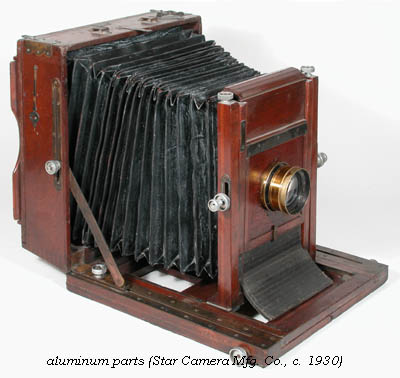 In
the 1850's, metallic aluminum was more costly than gold. Only in
1889 was a process developed that allowed the large-scale production of
aluminum. Accordingly, aluminum hardware is seldom seen on cameras
1870-1930. However, aluminum thumbscrews were apparently used as
original equipment on the rare Star Camera Mfg. Co. view camera, shown
at right.
In
the 1850's, metallic aluminum was more costly than gold. Only in
1889 was a process developed that allowed the large-scale production of
aluminum. Accordingly, aluminum hardware is seldom seen on cameras
1870-1930. However, aluminum thumbscrews were apparently used as
original equipment on the rare Star Camera Mfg. Co. view camera, shown
at right.
